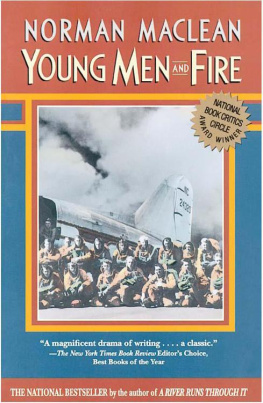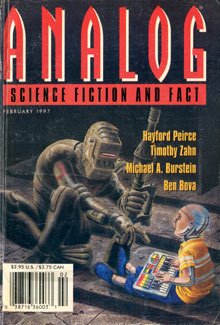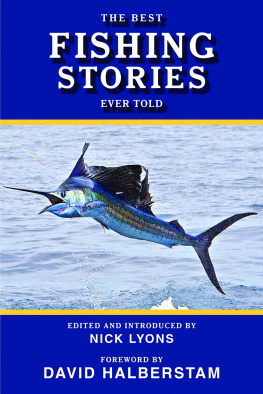Norman Maclean - A River Runs Through It and Other Stories, Twenty-fifth Anniversary Edition
Here you can read online Norman Maclean - A River Runs Through It and Other Stories, Twenty-fifth Anniversary Edition full text of the book (entire story) in english for free. Download pdf and epub, get meaning, cover and reviews about this ebook. year: 2001, publisher: University Of Chicago Press, genre: Detective and thriller. Description of the work, (preface) as well as reviews are available. Best literature library LitArk.com created for fans of good reading and offers a wide selection of genres:
Romance novel
Science fiction
Adventure
Detective
Science
History
Home and family
Prose
Art
Politics
Computer
Non-fiction
Religion
Business
Children
Humor
Choose a favorite category and find really read worthwhile books. Enjoy immersion in the world of imagination, feel the emotions of the characters or learn something new for yourself, make an fascinating discovery.
- Book:A River Runs Through It and Other Stories, Twenty-fifth Anniversary Edition
- Author:
- Publisher:University Of Chicago Press
- Genre:
- Year:2001
- Rating:5 / 5
- Favourites:Add to favourites
- Your mark:
- 100
- 1
- 2
- 3
- 4
- 5
A River Runs Through It and Other Stories, Twenty-fifth Anniversary Edition: summary, description and annotation
We offer to read an annotation, description, summary or preface (depends on what the author of the book "A River Runs Through It and Other Stories, Twenty-fifth Anniversary Edition" wrote himself). If you haven't found the necessary information about the book — write in the comments, we will try to find it.
A River Runs Through It and Other Stories, Twenty-fifth Anniversary Edition — read online for free the complete book (whole text) full work
Below is the text of the book, divided by pages. System saving the place of the last page read, allows you to conveniently read the book "A River Runs Through It and Other Stories, Twenty-fifth Anniversary Edition" online for free, without having to search again every time where you left off. Put a bookmark, and you can go to the page where you finished reading at any time.
Font size:
Interval:
Bookmark:
A RIVER RUNS THROUGH IT
and Other Stories
Norman Maclean
Twenty-fifth Anniversary Edition
Foreword by Annie Proulx
THE UNIVERSITY OF CHICAGO PRESS
Chicago and London
Norman Maclean (1902-1990) was the William Rainey Harper Professor of English at the University of Chicago. His book on Montanas Mann Gulch forest fire 1949, Young Men and Fire , is also available from the University of Chicago Press.
Annie Proulx is the author of a number of books, including Close Range: Wyoming Stories, Accordion Crimes , and Postcards. Her novel The Shipping News won both the National Book Award and the Pulitzer Prize.
The author and publisher wish to thank R. Williams for the book illustrations. Thanks are due as well to Region One of the United States Forest Service, and to the Montana Fish and Game Commission, for providing photographs on which some of the illustrations are based.
The University of Chicago Press, Chicago 60637
The University of Chicago Press, Ltd., London
(c) 1976 by The University of Chicago
Foreword (c) 2001 by Annie Proulx
All rights reserved. Published 2001
Printed in the United States of America
10 09 08 07 06 05 04 03 02 01 1 2 3 4 5
ISBN: 0-226-50072-1 (cloth)
ISBN: 0-226-50066-7 (paper)
ISBN: 978-0-226-50077-5 (Electronic)
Library of Congress Cataloging-in-Publication Data
Maclean, Norman, 1902-
A river runs through it and other stories / Norman Maclean. 25th anniversary ed. / with a new foreword by Annie Proulx.
p. cm.
Contents: A river runs through itLogging and pimping and Your pal, JimUSFS 1919.
ISBN 0-226-50072-1 (acid-free paper)ISBN 0-226-50066-7 (pbk.: acid-free paper)
1. MontanaSocial life and customsFiction. 2. Fathers and sonsFiction. 3. Fly fishingFiction. 4. BrothersFiction. I. Title.
PS3563. A317993 R58 2001
813.54dc21
2001035157
 The paper used in this publication meets the minimum requirements of the American National Standard for Information SciencesPermanence of Paper for Printed Library Materials, ANSI Z39.48-1992.
The paper used in this publication meets the minimum requirements of the American National Standard for Information SciencesPermanence of Paper for Printed Library Materials, ANSI Z39.48-1992.
For Jean and John to whom I have long told stories
CONTENTS
Foreword by Annie Proulx
Norman Fitzroy Maclean was born in Iowa on 23 December 1902 into a Scots-Presbyterian family with Nova Scotia roots. His brother Paul, born three years later, was murdered in 1938, the cruel event around which the title story twists. The father, John Norman Maclean, was a minister. When Norman was seven the family moved to Missoula, Montana, a place that burned its brand into Maclean hides, marking them for life. The father tutored the boys in religion, literature, and fly fishing. Paul became a master of the fly rod. When he was fifteen Norman Maclean started working for the U.S. Forest Service and saw the USFS as his calling in life until the summer of 1919 when he experienced the several epiphanies described in USFS 1919: The Ranger, the Cook, and a Hole in the Sky and his life cut into a new channel. He spent nearly all of his working life at the University of Chicago teaching English literature and writing scholarly essays, his last ten years as the William Rainey Harper Professor of English. In 1968 his wife of 37 years, Jessie, died. Five years later Maclean retired and took on the most intimate of writing projects, the metamorphosis of his own and the Maclean familys lives into literature. In 1976, when he was 73, A River Runs through It was published to the excited astonishment of critics and readers. A few more short pieces and essays followed, then the powerful Young Men and Fire , an exemplar of journalistic investigation into the Mann Gulch wildfire of 1949. In 1990 Norman Maclean died in body, but for hundreds of thousands of readers he will live as long as fish swim and books are made.
When A River Runs through It was published in 1976 I was living in low-life conditions in northern Vermont, logging country on the Quebec border, far from a bookstore, without electricity or telephone and no money. At the time I was just beginning to write fishing and hunting stories for Grays Sporting Journal. It was not until sometime in the 1980s, a hundred miles downstate but still living in a remote situationa decrepit farmhouse at the foot of a steep hillthat I read Norman Macleans little book.
It was late summer. I had been out west and on the way back, at OHare, I picked up a copy of A River Runs through It. The flight was two-thirds over when I started reading. When the plane landed in Burlington I was with Maclean, casting into the tricky red osiers along the shore. But I had to put the book away as there was a long drive to the farmhouse. When I got there it was late afternoon, the place washed with somnolent, old-gold light.
I hurled my suitcase into the hall, got a glass of water, and went to the porch to finish reading the story. There are few books that have the power to put the reader in such a deep trance that the real world falls utterly away. A River Runs through It has that power, and, when I read the famous last line, I am haunted by waters, I sighed and looked up. It was deepening twilight. In the long grass at the end of the porch, perhaps twenty feet distant, stood an uncommonly large bobcat, staring at me. It made no movement except for a slight twitching of its upward-curved tail. Such was the power of the story that I was still in the Arctic half-light of the canyon and the bobcat seemed on the bank of the river that runs through all things, and there it has stayed, forever joined in my mind to Macleans story.
Some years later, along with several other local writers, I was asked to read at a Dartmouth gathering to honor Maclean who attended and taught at the school from 1920 to 1926. The others read their own work, but when my turn came I could not, for my sentences seemed raw sticks beside the work of Maclean who learned the high art of literary architecture through his lifetime of teaching. And so I read the section of the title story of A River Runs through It that balances on both sides of the finest lineWhat a beautiful world it was once. In this stretch Maclean described the three parts of fishing water: the rapids, the deep bend, and the tail of the hole, which we comprehend not only as separate parts but as an entirety. The sequence, repeated again and again, as anyone who fishes living water knows, makes a river. The parts of a river can also be seen as the stages of life, the flow of time. In the afterword of the 1983 edition Maclean wrote that the artistic unity of the story is modeled on this fishing water; the section I chose to read that night was the curve of a story. Almost no other authors work reads aloud as well as Macleans, elegiac and haunting and taut.
It is one of the rare truly great stories in American literatureallegory, requiem, memoirand so powerful and enormous in symbol and regret for a lost time and a lost brother, for human mortality and the consciousness of beauty, that it becomes part of the life experience of the reader, unforgettable. Many critics were astonished that a writer in his seventies could have produced such a masterpiece as a first venture. But, in fact, is that not when we should expect the fire and ice, the distillation of a lifes hard experience filtered through decades of immersion in the worlds literature? Given Macleans Scots-Presbyterian youth on river and in woods of rough country, his personal knowledge of loss and grief, his sense of rhythm and structure, his ceaselessly inquisitive mind, we ought not feel surprise but a sense of satisfied justice that he got it right the first time out.
Maclean possessed remarkable story sense. In a talk, Teaching and Story Telling, that he gave at both the University of Chicago and Montana State University in 1978, he explained its source:
Next pageFont size:
Interval:
Bookmark:
Similar books «A River Runs Through It and Other Stories, Twenty-fifth Anniversary Edition»
Look at similar books to A River Runs Through It and Other Stories, Twenty-fifth Anniversary Edition. We have selected literature similar in name and meaning in the hope of providing readers with more options to find new, interesting, not yet read works.
Discussion, reviews of the book A River Runs Through It and Other Stories, Twenty-fifth Anniversary Edition and just readers' own opinions. Leave your comments, write what you think about the work, its meaning or the main characters. Specify what exactly you liked and what you didn't like, and why you think so.













